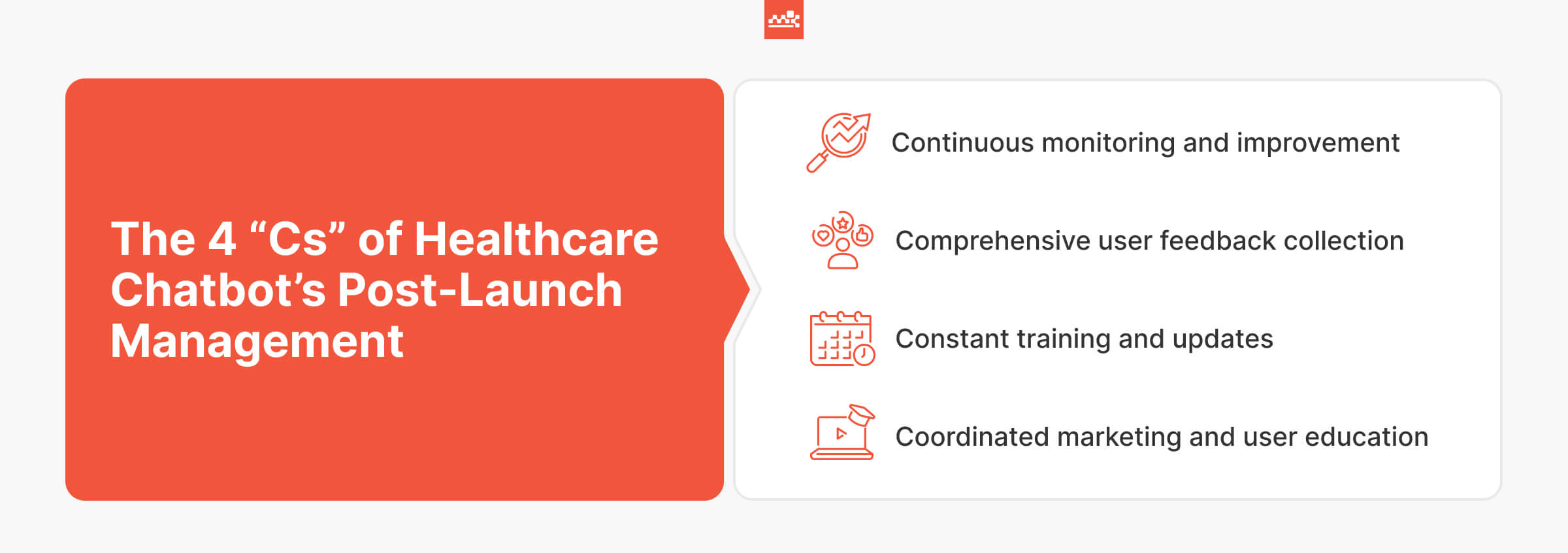In the healthcare industry, businesses are actively exploring technologies to enhance care quality. Most medical settings are already benefiting from Electronic Health Records, Telehealth, wearable health-monitoring devices, and AI-driven diagnostic tools.
At Master of Code Global, we’ve also built a multi-platform solution for hospital management. This app includes automated tools for capital expenditure forecasting, investment level modeling, and proactive optimization, resulting in a 15-fold revenue growth over two years.
These are just a few instances of modern innovations in such a demanding field. One more essential tool, used by about one-third of physicians, is the healthcare chatbot. Many patients also see the potential in artificial intelligence, with 40% of Americans believing it could minimize errors.

Given the increasing trend for AI integration, we’ve developed a roadmap for medical companies aiming for successful bot launches. Keeping these tips in mind, you will be able to boost service efficiency and cut administrative costs. So, without further ado, let’s delve into the details.
Table of Contents
Step 1. Analyzing the Healthcare Landscape for Chatbot Adoption
Firstly, it’s essential to grasp market demands and patient views on medical technology usage. We’ve collected insights from recent surveys to illustrate industry trends:
- 42% of physicians acknowledge the importance of virtual assistants in healthcare.
- Within five years, 44% of doctors are likely to recommend bots to their patients.
- Interactive agents are believed to aid in self-health management (54%) and offer quicker access to care (53%).
- 62% of clinicians see benefits in organizational aspects, particularly in appointment scheduling (78%), finding clinics (76%), and dispensing medicine details (71%).
- Chatbots can also contribute to improved nutrition (65%), better medication adherence (60%), increased physical activity (55%), and stress reduction (51%).

- AI-powered instruments gaining traction among patients include virtual nurses for monitoring (52%), virtual health coaches (52%), assistants for handling costs, appointments, and coverage (45%), and tools for diagnosis assistance (45%).
- Around 40% of adults are comfortable with the technology managing services, including diagnosing and recommending treatments.
- Similarly, 40% believe AI will lead to superior care outcomes.
The statistics clearly point to a growing interest in medical chatbots. With this understanding, let’s look at the investment worthiness of bots in the domain.
Step 2. Estimating the Potential Impact of Healthcare Chatbots
Advantages of Chatbots in Healthcare
Before implementing a solution in a medical setting, it’s crucial to understand what pros and cons you may face in the process. Let’s first review the major benefits of chatbots in healthcare institutions.

Here is what these solutions can do:
- Data-driven healthcare strategies. Utilizes patient records to improve service quality and make informed decisions.
- 24/7 care access. Provides continuous support and information, anytime and anywhere.
- Boosting patient knowledge. Enhances understanding of conditions and treatments for educated decision-making.
- Administrative workload reduction. Automates routine assignments, freeing up time for caregivers to focus on treatment.
- Rapid medical evaluation. Quickly assesses symptoms, aiding in faster and more effective diagnostics.
- Custom health guidance and care tips. Delivers personalized advice and recommendations based on individual needs.
- Enhancing treatment adherence. Sends reminders for medication and appointments, promoting patient compliance.
- Cost-efficient healthcare management. Reduces operational costs by automating tasks and improving process optimization.
Calculating the ROI of Healthcare Chatbots
Improving care quality and access is key for any technology in this sector. Yet, it’s equally important to realize expected returns on investment (ROI) for further growth. Estimating ROI typically involves evaluating the financial impact of AI-driven tools.
At Master of Code Global, we’ve developed a Chatbot ROI Calculator for this purpose. Our instrument predicts potential savings prior to bot deployment. The calculator compares existing expenses against those projected with a chat assistant in place. It evaluates different factors to measure the monetary gains from a chatbot. Consider using it or a similar tool when determining the value of your future solution.
Step 3. Choosing the Right Use Cases for Effective Bot Adoption
Having determined the ROI and the potential benefits for your medical business, we can now shift our focus to chatbot healthcare use cases. Tailoring to your distinct needs and objectives, you may find one or several of these scenarios particularly relevant.

Patient-Faced Applications:
Symptom Assessment Assistant
A chatbot for medical diagnosis interprets symptoms, suggesting potential conditions for further evaluation. It offers an accessible way for patients to begin their care journey from home. This early engagement can lead to timely intervention.
Business value. Accelerates initial assessments, reducing in-clinic wait times and optimizing healthcare delivery.
Real-world example. Cleveland Clinic launched an AI-driven COVID-19 screening tool online. It assessed users’ symptoms as per CDC guidelines, categorizing their risk level. Vulnerable individuals were advised for further medical consultation. This instrument attracted 145,000 patients in its initial six weeks.
24/7 Support and Engagement
A patient engagement chatbot provides constant assistance, answering queries and offering guidance at any time. It ensures people always have access to the information and help they need. The bot plays a vital role in keeping individuals connected to their care providers.
Business value. Enhances customer satisfaction and loyalty, crucial for institutions’ success and reputation.
Business value. Alder Hey Children’s Hospital’s “Ask Oli” is an illustration of how AI can revolutionize pediatric healthcare. Through real-time interactions, it soothes the anxieties of young patients and their families. As a result, the treatment is perceived as a less intimidating experience.
See how AI is redefining patient care with chatbots in healthcare settings.

Patient Education
Conversational agents serve as an educational resource, delivering personalized health data and guidance. It simplifies complex medical concepts, making them accessible and understandable. Thus, individuals are empowered with knowledge about their conditions and care options.
Business value. Promotes informed patient decision-making, leading to potentially reduced costs and improved health outcomes.
Real-world example. Northwell Health’s AI-driven chatbot assists women during and after pregnancy. It provides tailored information based on pregnancy stages and risk factors. This way women can recognize early signs of complications. The tool has been effective in identifying urgent health issues, proving its value in patient education and safety.
Mental Health Support
Patients can also get immediate emotional support and guidance using a virtual counselor. These bots are particularly beneficial in areas where such services are inaccessible. They engage users in therapeutic conversations, providing coping strategies and mental health education.
Business value. Increases care accessibility, improving overall community wellness and reducing healthcare disparities.
Real-world example. ChatPal, a multilingual chatbot, supports mental well-being in rural regions. Focusing on territories with limited access to psychological aid, it addresses critical gaps in service provision. People receive the required assistance and recommendations to improve their emotional state. This initiative demonstrates how chatbots can make care more inclusive and accessible.
Appointment Scheduling and FAQs
Doctor appointment chatbots facilitate efficient scheduling and swiftly handle health-related questions. Patients are provided with convenient, round-the-clock access to vital knowledge and booking aid. By automating these tasks, organizations can reduce administrative workload and enhance the overall care experience.
Business value. Improves efficiency and satisfaction through automation, leading to cost savings.

Real-world example. UCHealth’s virtual assistant “Livi” is powered by Conversational AI for healthcare. It offers a comprehensive range of operations through smart speaker devices. Livi helps with finding doctors, services, and health information. The tool enhances patient interaction and accessibility contributing to a positive image of the hospital.
Internal Usage:
Automated Recruitment Assistance
Talent acquisition can also be optimized by conversational agents. They help staff with pre-screening candidates and answering their questions. Other functions include guiding applicants through the procedure and gathering relevant data. Recruiters can leverage chatbots to automate interview scheduling.
Business value. Reduce time and resources spent on initial candidate assessment and coordination. Ensure a more organized and timely hiring process.
Example. The Children’s Healthcare of Atlanta chatbot assists in job searches, offering position recommendations based on user-provided details. It streamlines the selection, collecting personal data and qualifications for chosen positions. Additionally, the bot addresses common hiring-related queries. This tool significantly eases the team’s workload by simplifying the recruitment lifecycle.
Medical AI Assistant
Physicians can benefit from using bots as their AI-powered aids. Such medical assistants monitor patient health remotely, suggest evidence-based treatment options, and even translate documents. This empowers doctors to dedicate their expertise to complex cases, supporting clinical decision-making.
Business value. Increased productivity of care providers and improved patient experience.
Example. Google’s Med-PaLM-2 chatbot, tested at Mayo Clinic, is designed to enhance staff assistance. It provides diagnoses as per symptoms, and performs tasks like summarizing consultation notes or organizing patient data. The bot’s training includes medical demonstrations and exam answers. Such preparation enables more accurate health-related conversations.
Medical Research Navigator
Clinical chatbots streamline access to the latest studies and data. Doctors can utilize them to instantly search vast databases and identify relevant sources. The information is further used for quicker diagnosis and more effective treatment management.
Business value. Improve patient outcomes and contribute to more informed clinical practices.
Example. At Massachusetts General Hospital, a new AI chatbot for healthcare is undergoing tests. This tool is designed to explore scientific articles, offering results in a conversational format. The bot is cited to save time in research, thus enhancing patient-doctor interactions.
Clerical Workload Relief
A hospital chatbot significantly reduces administrative burdens in healthcare settings. It automates routine clerical tasks, such as data entry and record-keeping, freeing staff for more critical duties. This tool also streamlines patient check-in processes and efficiently manages document flow.
Business value. Increases operational efficiency and staff productivity.
Example. Kaiser Permanente’s AI chatbot aids patients in navigating their treatment options. It handles initial inquiries and basic diagnostic questions. The bot allows medical personnel to focus more on direct customer care and complex procedures.
Supervisory Support and Onboarding Aide
The last but not the least function of assistants we’re covering is their role in training new employees. Nurse chatbots can guide newcomers through various procedures, rules, and other work-related aspects. They are also able to connect them with supervisors for additional support when needed.
Business value. Facilitate smoother onboarding and ensure patient safety.

Example. Master of Code fine-tuned and transitioned an existing internal communication chatbot of a biotechnology company onto a new system. This tool assists newbies by providing instant access to advice from supervisors. The aim was to enhance the resolution of customer queries and improve the overall efficiency of the team.
Step 4. Selecting the Reliable Medical Chatbot Provider
After identifying your specific use case and objectives, the next move involves picking a technological partner to develop your AI chatbot for healthcare. To assist in this decision-making process, we have compiled a list of key questions. These will guide you in choosing the most suitable provider available in the market:
- Does the company have a background in developing industry-specific conversational agents?
- How customizable are their solutions to ensure meeting distinct business demands?
- Do they offer all the features you need, such as natural language processing, multi-language support, integration with existing systems, and data analytics?
- What are their pricing models for chatbot development? Do they offer transparent pricing structures that align with your budget and project needs?
- How does the provider guarantee security and compliance with relevant regulations like HIPAA?
- Are their chatbots scalable to handle future growth and evolving needs?
- What is their experience with Generative AI in healthcare, and how can they leverage it for chatbot development?
After considering the questions, you may find that Master of Code Global is one of the partners fitting these criteria. Our approach involves specialized skills and innovative strategies to maximize your project’s ROI, aligning with your long-term business goals. Our expertise in AI and LLM-powered chatbots, along with a track record of successful implementations, positions us as a dependable partner. We focus on developing, training, and integrating bots into existing infrastructures, ensuring they align with your strategic vision.
Step 5. Tackling Challenges in Chatbots for Healthcare Deployment
To successfully incorporate an AI chatbot in healthcare operations, you and your tech partner must navigate several key challenges. Here is an overview of these issues and their solutions for your consideration:
Accuracy and reliability of AI diagnostics. Ensure veracity and robustness through rigorous testing, validation by medical professionals, and transparency about limitations.
Data privacy & security. Prioritize strong encryption, comply with regulations, and clearly communicate information processing practices to build confidence in a solution.
User trust & acceptance. Focus on transparency, education, and human oversight to address concerns and establish ethical implementation.
Handling complex and sensitive interactions. Train chatbots for specific scenarios, integrate natural language processing and offer escalation paths to human specialists.
Integration with existing healthcare systems. Choose flexible platforms that seamlessly connect with the current IT infrastructure for efficient data exchange.
Addressing these issues effectively guarantees the smooth functioning and acceptance of AI chatbots in medical settings.
Step 6. Post-Launch Strategies for Healthcare Chatbot Success
Yet, launching a virtual assistant is just the beginning. Its effectiveness depends on ongoing maintenance. Here are the four ‘Cs’ tactics for further productive use of chatbots in healthcare.

- Continuous Monitoring & Improvement
- Track key performance indicators like user satisfaction, task completion rates, and error frequency.
- Analyze interactions to identify areas for advancement and refine bot responses.
- Comprehensive User Feedback Collection
- Implement mechanisms to gather patient reviews regarding their chatbot experience and suggestions.
- Examine metrics to understand individual needs and preferences, informing future upgrades of the virtual agent.
- Constant Training and Updates
- Regularly update the tool with new information and data to maintain accuracy and relevance.
- Stay informed about evolving regulations to adapt the bot accordingly.
- Coordinated Marketing and User Education
- Develop clear communication strategies to inform the audience about the chatbot’s purpose and capabilities.
- Educate patients on how to interact with the assistant effectively to maximize its benefits.
By actively monitoring, gathering feedback, iterating, and educating users, you can ensure your healthcare chatbot continues to evolve and deliver value in the long run.
Summing Up
All in all, the successful launch of a healthcare assistant involves meticulous planning. It’s vital to stay informed about market trends, focus on pertinent use cases, and choose an appropriate technology partner. This way, you can effectively leverage AI to enhance patient experience, reduce operational costs, and provide more efficient, accessible services.
With the ongoing advancements in Generative AI in the pharma and medical field, the future of chatbots in healthcare is indeed bright. This technology infuses bots with the capability for deeper engagement and personalized interactions. As conversational agents evolve, they foster trust, empower patients, and contribute to enhanced health outcomes.
To stay ahead in the industry, start implementing a chatbot now. This strategic move will position your organization to deliver superior care quality, today and in the future.
Find out how the healthcare chatbot from Master of Code Global can revolutionize patient care and optimize clinic operations.






